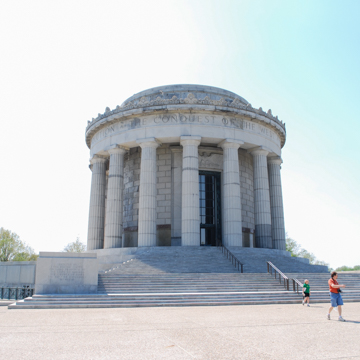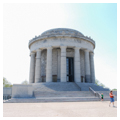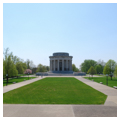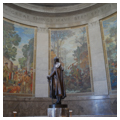The George Rogers Clark National Historical Park encompasses about 24 landscaped acres along the Wabash River in Vicennes, Indiana. At its heart is the George Rogers Clark Memorial, erected to commemorate the location of Clark’s capturing of Fort Sackville from the British in February 1779, which brought the Northwest Territory into the American fold. Although Fort Sackville’s exact position is unknown, it was located within the current park’s boundaries. In the nineteenth century, the site was occupied with a succession of warehouses and factories. By the 1920s, with the sesquicentennial of the Revolutionary War, there was growing interest in commemorating the site and its heroes. The newly established George Rogers Clark Sesquicentennial Commission determined to build a permanent memorial “at or near the site of Fort Sackville.” The State of Indiana, with additional funding from the federal government, cleared the nineteenth-century buildings from the site and established a City Beautiful–style civic landscape immediately adjacent to downtown Vincennes.
Landscape architect William E. Parsons designed the park along the river’s neoclassical floodwall, which is of poured concrete. Near the park’s north corner is the Lincoln Memorial Bridge (1931), with distinctive Art Deco pylons flanking the approach, along what was then the federal highway (now IN 441) across the river. The two huge stylized figures of Native American chiefs in relief on the pylons are the work of French sculptor Raoul Josset; although they were intended to be generic figures, the public named them for Tecumseh and his brother the Prophet, who had nothing to do with the fort.
The George Rogers Clark Memorial, designed by Frederic C. Hirons of Hirons and Mellor of New York, is a massive circular raised temple of granite, surrounded by a colonnade of sixteen Doric columns, following the model of the Tholos of Delphi. Inside is a heroic bronze statue of Clark, hero of Vincennes, sculpted by Hermon A. MacNeil. The interior walls are graced with huge murals by Ezra Winter depicting episodes of Clark’s campaign.
Northwest of the Memorial is a heroic granite statue of a seated Francis Vigo, a merchant who helped the campaign and worked against the British. Dedicated in 1936 along with the Memorial, the statue was a two-year effort of New York sculptor John Angel. East of the Memorial is a plaza in front of the adjacent Old Cathedral (Basilica of St. Francis Xavier), which was built in 1826. In the plaza is a bronze sculpture of Father Pierre Gibault, who rallied local French support for Clark and helped his campaign. The statue, completed in 1935, is the work of Czech-born Albin Polasek of Chicago.
The National Park Service took over the grounds in 1966 to establish the George Rogers Clark National Historical Park. The park was closed in 2008–2009 for a massive restoration project to improve drainage, repair the monuments, and renovate the access steps.
References
George Rogers Clark National Historical Park. National Park Service. Accessed March 21, 2018. http://www.nps.gov/.
Greiff, Glory-June. Remembrance, Faith, and Fancy: Outdoor Public Sculpture in Indiana. Indianapolis: Indiana Historical Society, 2005.
Simmons, Virgil, et al., eds. Indiana Review. Indianapolis: n.p., 1938.








